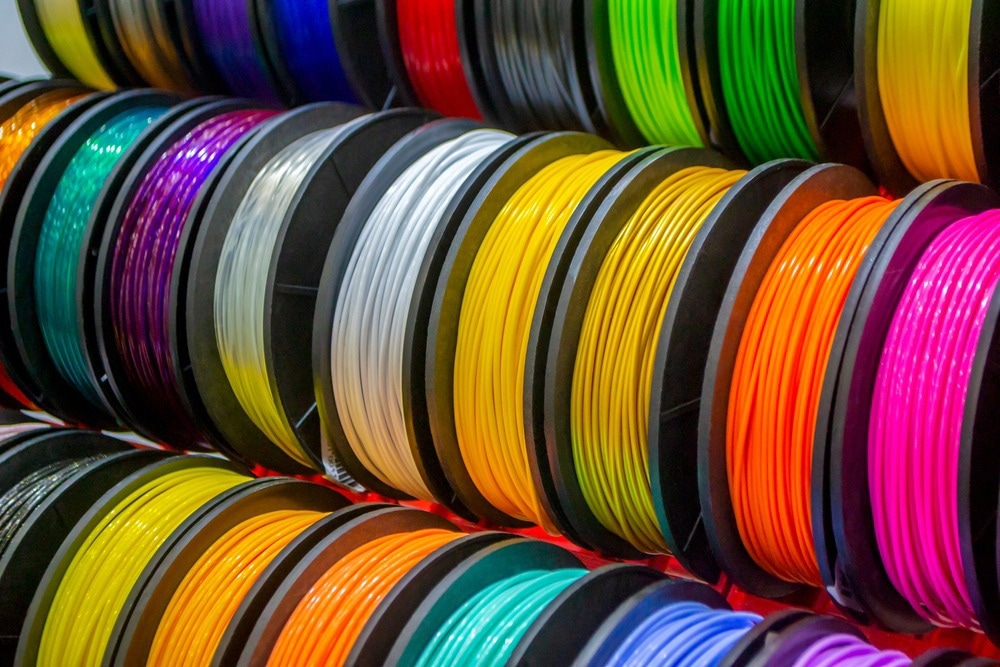3D printing, an additive manufacturing (AM) technique, has the potential to revolutionize how we produce objects that we want and need in the modern world. Among other developments, innovations in polymer materials science will help 3D printing realize its full potential in the next few years.

Image Credit: MarinaGrigorivna/Shutterstock.com
The first 3D printing process, stereolithography, involved hardening a photosensitive polymer with a laser, and plastics have remained at the forefront of the industry. In fact, market analysts IDTechEx predict that the global polymer 3D printing market will be worth a staggering $21 billion by 2033.
To appreciate this growth, it is important to look beyond the historical use of polymers in 3D printing and consider the innovative developments that have emerged in recent years.
Industrial Benefits of 3D Printing
3D printing provides a number of benefits over traditional production methods. The ability to create virtually any 3D shape enables designers to produce parts that outperform or cost less than conventionally made parts is a major benefit. For example, Airbus has created a titanium bracket that is 30% lighter than its predecessor without sacrificing performance or durability.
3D printing also enables mass-scale customization, as every part produced by a machine can be unique without requiring molds or fixed tooling. This is exemplified by test equipment maker Vectoflow, which uses AM techniques to create bespoke probes for fluid flow-measurement applications.
3D printing speeds up both product development and production by eliminating time-consuming toolmaking and fabrication operations. The Ariane 6 rocket, for example, uses a fuel injector head that is additively manufactured as a single piece of nickel-based alloy, whereas previous versions required welding 248 individually machined components together.
3D printing simplifies the maintenance and support of products in the field in general, reducing the need for spare parts inventories by enabling the on-demand production of items from digital files. For instance, carmaker Mercedes-Benz uses AM to manufacture spare parts for its classic vehicles.
Polymer Innovation for 3D Printing
Despite being around for 40 years, the AM industry is still rapidly growing, with a market worth of €13.4 billion and a 22% annual growth rate in 2020. With over 200 companies competing in hardware, software, and materials development, the industry is constantly evolving.
The applications for 3D printing polymers are vast and can range from creating large investment casting patterns for rocket components at SpaceX to mass custom manufacturing of Invisalign Clear Aligner tooling for teeth straightening.
As 3D printing technology improves, so does the range of available materials, including medical-grade polymers. However, developing polymers that are suitable for 3D printing is a complex and time-consuming process.
The environmental aspect of polymers has become a key issue, and the industry is seeing an increase in recycled and recyclable filaments made from reclaimed plastic waste.
Performance is also important, and manufacturers are constantly seeking to improve the characteristics of materials that can be combined to meet market demands. For instance, startup Tiamet 3D has developed a composite based on PLA and nano-diamonds to provide a resistant and accessible material for users. Other manufacturers offer better materials, such as those that are flame resistant or have ESD properties.
3D Printing Conducting Polymers
In a recent article published in the journal Nature Communications, researchers from Massachusetts Institute of Technology (MIT) introduced a high-performance 3D printable conducting polymer ink based on poly(3,4-ethylenedioxythiophene):polystyrene sulfonate (PEDOT:PSS) for 3D printing conducting polymers.
Conducting polymers are promising material candidates for a range of applications, including energy storage, flexible electronics, and bioelectronics. However, traditional fabrication methods such as ink-jet printing, screen printing, and electron-beam lithography have limitations that have hindered the rapid innovation and broad applications of conducting polymers.
The team's 3D printable conducting polymer ink enables the fabrication of high-resolution and high-aspect-ratio microstructures that can be integrated with other materials, such as insulating elastomers, via multi-material 3D printing. The 3D-printed conducting polymers can also be converted into highly conductive and soft hydrogel microstructures.
The researchers demonstrated fast and streamlined fabrications of various conducting polymer devices, including a soft neural probe capable of in vivo single-unit recording.
New Polymer Feedstock from 3D Systems
One of the newest 3D printing polymer feedstock materials on the market addresses the major promising application area of additive manufacturing: the mass production of simple plastic parts. 3D Systems has released Figure 4 Production Black 10 (PRO-BLK 10), which is the first "direct" photopolymer that produces parts with production-grade properties.
The non-contact membrane digital light processing (DLP) technology used by 3D Systems with Figure 4 Production Black 10 is fast, and the new photopolymer does not require a long period in an oven after printing to achieve production part properties. It has an elevated level of yield with 12 percent elongation break, which makes it behave almost identically to a thermoplastic. It also has environmental stability, which is necessary for a production part.
More from AZoM: The Global 3D Printing Market - Growth, Trends, and Applications
References and Further Reading
Bromberger, J., et al (2022). The mainstreaming of additive manufacturing. [Online] McKinsey. Available at: https://www.mckinsey.com/capabilities/operations/our-insights/the-mainstreaming-of-additive-manufacturing (Accessed on 7 April 2023).
Madeleine, P. (2023). Polymer 3D Printing Is Being Driven by Material and Technological Innovations. [Online] 3D Natives. Available at: https://www.3dnatives.com/en/polymer-3d-printing-material-technological-innovations-140220236 (Accessed on 7 April 2023).
Sinkora, E. (2020). New Polymer Applications in Additive Manufacturing. [Online] SME. Available at: https://www.sme.org/technologies/articles/2020/march/new-polymer-applications-in-additive-manufacturing/ (Accessed on 7 April 2023).
Yuk, H., et al (2020). 3D printing of conducting polymers. Nature Communications. doi.org/10.1038/s41467-020-15316-7.
Disclaimer: The views expressed here are those of the author expressed in their private capacity and do not necessarily represent the views of AZoM.com Limited T/A AZoNetwork the owner and operator of this website. This disclaimer forms part of the Terms and conditions of use of this website.